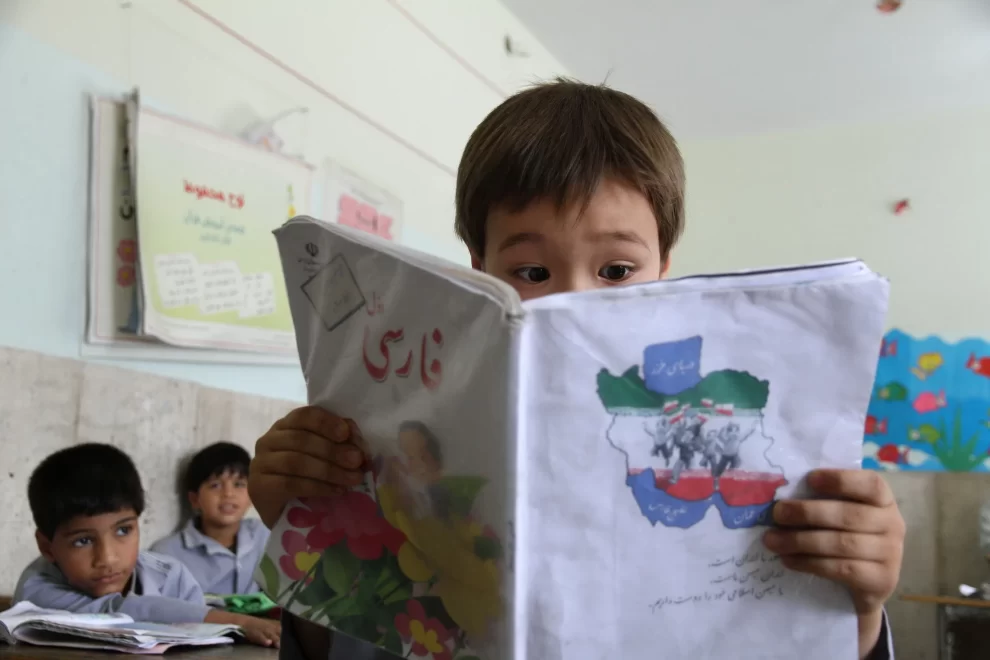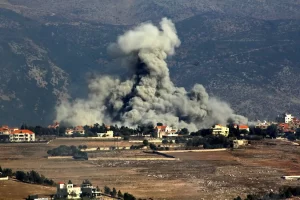MYTH: Iran’s education system is of poor quality and focuses primarily on religious studies. Higher education in the country is noncompetitive and unpopular. Moreover, the educational system is discriminatory, with women receiving fewer years of school and a lower quality of education than men.
FACT: While Iran’s education system requires improvement, Iranian schools provide quality education for both men and women in science and humanities that is comparable to other countries in the region.
Introduction
Iran’s education system is plagued by false perceptions and stereotypes that distort the realities of Iranian schooling. While many expect Iran’s education system to be dominated by religious fundamentalism, the reality is that Iranian education is largely comprehensive and strives to meet the needs of the modern labor market. Iran spends approximately 3.6 percent of its GDP on education, which amounts to about 23.1 percent of Iran’s total government expenditures. This matches the global average (3.7 percent) of government expenditures on education, and exceeds the spending of many other Middle Eastern countries such as Qatar (3.2 percent) and Jordan (3.0 percent). As a result, Iran has an educational expenditure of $1557.7 per primary school student, $2456 per secondary school student, and $3185.3 per tertiary school student. To show for its investment, Iran has a literacy rate of 85.5 percent, which rises to 98.1 percent when looking specifically at Iranians ages 15-24, indicating an even more positive outlook for Iranian education in the near future.
Overview
Iran’s education system is highly centralized, with all public schools falling under the control of the Ministry of Public Education and Training. Likewise, all Iranian universities fall under the supervision of the Ministry of Higher Education and Culture, and all medical schools are overseen by the Ministry of Health, Treatment, and Culture. The Ministry of Public Education and Training plays an active role in the education of Iranian students. It is ultimately the Ministry’s responsibility to determine educational planning, school financing, administration, curriculum, teacher training, and textbook development. Iran’s Supreme Educational Council, a distinct and autonomous legislative body tasked with reporting on the state of Iranian schools to the Supreme Council of the Cultural Revolution, also plays a significant role in school programming: adopting and mechanizing executive educational policies, improving education structures and processes, and monitoring the implementation of educational programs.
The Iranian school system can be divided into two primary levels: primary education and secondary education. Many families, however, also opt to also enroll their child/children in pre-primary education, with about 64.4 percent of children attending pre-primary care at the age of 5. In Iran, primary education encompasses a 6 year long period of schooling, which begins at the age of 6 for most children. Primary education is compulsory and free, and as a result, 99.8 percent of Iranian children ages 6-12 are enrolled in primary schools. After completing primary education, Iranian students enter into secondary education, which is divided into two phases: lower secondary education and upper secondary education. Lower secondary education encompasses a 3 year period from 7th-9th grade, and is also compulsory for all students. However, once students have completed lower secondary education, the 3 additional years of upper secondary education are optional. Despite this, upper secondary education remains free to all Iranians, and most children continue in school to complete upper secondary education, with 95.7 percent of students continuing enrollment in school after primary education. In Iran, the upper secondary level of education is divided into three unique paths: an academic path, technical path, and vocational path. A student’s academic branch is determined by the results of examinations taken at the end of lower secondary education. All three branches encompass a period of 3 years, with completion of any of the pathways leading to the attainment of a high-school diploma. Additionally, those students who complete either the technical or vocational pathways also receive a Technician’s Certificate.
Upon completion of secondary education, all students who intend to continue onto tertiary academic education are required to take a national standardized admissions exam known as the Konkur. In the past, students were required to take a “Pre-University” year to study and prepare for the Konkur. However, in 2013, reforms to the Iranian education system phased out this requirement, leaving it as an optional choice to be taken by students. The Konkur itself is a highly rigorous exam, assessing a comprehensive spread of general knowledge, Persian language, history, math, and a foreign language. The exam is known to be extremely challenging, with only about 10 percent of test takers finding placement at a public university. The Konkur exam is open to people of all different backgrounds; in 2021, the ages of Konkur test-takers ranged from 13 years old at the youngest to 81 years old at the oldest. Additionally, 59.5 percent of all test-takers were female.
Tertiary education remains a very popular pathway in Iran; 58.2 percent of Iranians aged 18-22 are currently enrolled at a post-secondary education institution. In Iran, tertiary education takes place in a combination of public and private institutions. Iran has 46 universities, 60 post-secondary technical institutes, about 200 colleges and professional schools, and a handful of teacher training colleges. The cost of tertiary education varies across schools, with free college education being guaranteed at most public institutions while private institutions typically charge a low price for enrollment. Those students who followed the technical or vocational pathways through upper secondary education typically go on to pursue a Technician Associate Degree (Kardani), which is completed in approximately two years. Students who pursue this technical pathway do not need to take the Konkur, but are usually required to sit for some entrance exam before being admitted. The students who choose to follow an academic path can typically obtain a Bachelor’s Degree (Karshenasi) after 4-5 years of study, with a Master’s Degree (Karshenasi Arshad) taking an additional 2 years of study. Those interested in higher academia are then able to attain a Doctorate (Doctora) after 4 or more years of additional study.
Attaining a college education in Iran is often a prerequisite to accessing well-paying and stable employment opportunities. However, in recent years, persistently poor economic conditions in Iran have created an “Over-Education Crisis”, whereby Iranian schools have produced significantly more college graduates than the domestic Iranian economy can absorb. A staggering 7.4 percent of all Iranian adults are currently in college, a number comparable to that of the United States, which has far more economic opportunities for college educated adults than Iran. This has helped foment domestic unrest within Iran, as many college graduates become dissatisfied with their inability to utilize their laboriously attained credentials. It has also contributed to “Brain Drain”, with many Iranian graduates (especially those coming from top universities) seeking employment in other countries. This has led to a significant loss of expertise, innovation, and productivity in Iran that only perpetuates the poor economic conditions that created the Over-Education and Brain Drain crises to begin with.
Curriculum
In primary education, Iranian students are taught a wide-reaching curriculum encompassing Farsi, mathematics, science, social studies (including history and geography), art, physical education, and religious education and Qur’anic studies. Once students progress to lower secondary education, they are exposed further to the physical sciences, social sciences, humanities, and art. Additionally, all students can receive foreign language instruction in English, French, or German. Students are also able to access vocational or defense training—though defense training is only accessible to male students. At the upper secondary level, students are able to choose which of the academic, technical, or vocational tracks they want to follow. Those who pursue the academic path are prepared for higher education; students are able to select pathways focused on mathematics, physics and chemistry, natural science, or the social sciences and humanities. The students who opt to follow the technical or vocational paths are prepared to join the workforce straight out of high-school, following a very different curriculum from students on the academic course.
While Iran’s national education curriculum is highly comprehensive and strives to meet the needs of the modern Iranian economy, its high degree of government control also leaves it vulnerable to many religious and political influences. As such, it has been documented in the past that Iranian textbooks and curriculum have included teachings that are strongly pro-Islam and anti-West. These teachings tend to emphasize Islam as a means of national unity and mask the shortcomings and oppressive actions of the Iranian government. However, it is notable that heavily propagandized versions of religion and history have been gradually toned down throughout the evolution of the Iranian education system and the primary focus of Iran’s educational planners now is to develop a school curriculum that is scientific and research-driven but also aligns with Islamic religious values.
Women’s Education
The education of women in Iran is a challenging topic. On the one hand, there remains unquestionable institutionalized gender inequality within Iranian schools that actively damages the quality of education that women receive. All Iranian schools are segregated by gender, both in regards to students and teachers. Iranian textbooks have been known to contain images and writings that discriminate against women in favor of men. Further, it is reported that there are 3 times as many school-aged girls who are deprived of an education as school-aged boys. On the other hand, Iran has made truly immense strides in the areas of female literacy, primary educational enrollment, and higher education. In 1976, Iran’s female literacy rate was only 24 percent; since then, it has more than tripled to 80.8 percent in 2016. Furthermore, when looking specifically at young Iranians (ages 15-24), there exists an only 4 percent difference in female-male literacy, indicating that modern Iranian education is working to shrink gender inequities. The number of women who complete primary school has also increased tremendously, with 99 percent of school-aged girls having completed primary school in 2017. In 2019, Iranian girls received an average of 10.3 years of schooling, just marginally behind the average of 10.4 years for boys. Perhaps most notable, though, is the female dominance of higher education. Female enrollment in tertiary education increased nearly twenty-fold between 1978 and 2018. At times, Iranian women even outnumbered men two to one at the university level. Additionally, 70 percent of the 233,695 STEM graduates in Iran are women, a sharp contrast to the dominant gender norms of the United States, where women make up only 27 percent of STEM workers. Despite these marked accomplishments of Iran’s education system, there still undoubtedly remain many systemic problems that women face in Iranian schools. However, it would be wrong to consider education to be a wholly opportunity-less space for Iranian women.
Poverty
The greatest challenge facing Iranian students today is poverty. In 2017, 10.9 percent of Iranians lived below the poverty line, with that number rising dramatically to 27 percent when focusing specifically on rural areas. Adverse economic conditions across the country, in particular Iran’s rural regions, continue to force many students to drop out of school in order to join the labor market. According to Iranian officials, 53 percent of all school dropouts occur due to financial difficulties. Despite an official ban by the Iranian government on child labor, there are an estimated 7 million child workers in Iran. Poor economic conditions have also hampered funding for schools. Across Iran there are an estimated 32,000 schools (one-third of all schools in the country), that are in need of razing and reconstruction due to their present state of disrepair. These challenges are only further exacerbated in rural regions of Iran where poverty is not only far more prevalent, but also has a greater impact on the quality of education being offered to Iranian students. Poor schools conditions, irrelevant school programs, long distances, poor roads, and limited educational materials and equipment all contribute to comparably worse school conditions across rural regions of Iran. The disparity between urban and rural Iranian schools became particularly apparent during the COVID-19 pandemic, when resources like stable internet access became essential to educational attainment. Some Iranian parents, especially those in rural areas, don’t even have access to cell phones, and 6.9 percent of Iranian students (approximately 870,000 people) don’t have access to the internet at home in any capacity. While Iran has made impressive strides across the decades to address educational inequalities between rich and poor, urban and rural, much more work is urgently needed to fully root out these persisting economic inequities in the Iranian education system.
Conclusion
While many aspects of Iran’s education system are still in need of reform, it is also undeniable that Iran’s schools have made vast progress in meeting the demands of the modern Iranian labor market. Indeed, while religious teachings and gender inequities within Iranian schools remain, significant advancement has been made in ensuring a research driven education for all students. As such, Iran has seen impressive gains in its literacy rate, average years of schooling, and post-secondary enrollment—across gender lines. From primary education through tertiary education, Iran’s modern network of schools is comparable to other countries of similar income and size.
Source: AIC






































